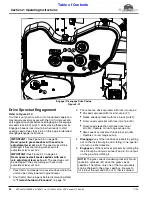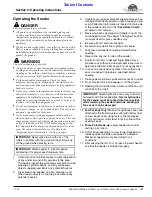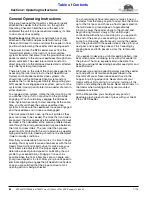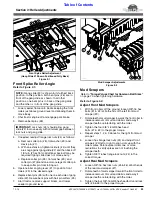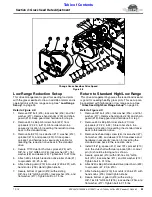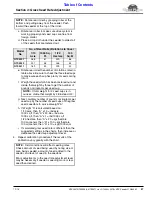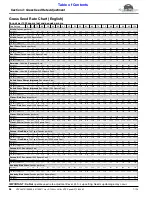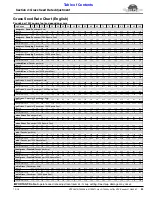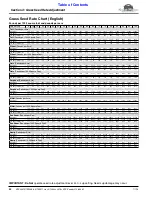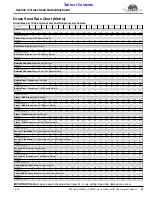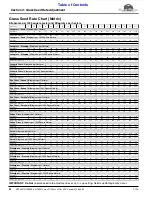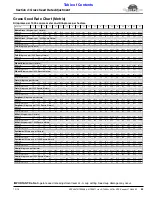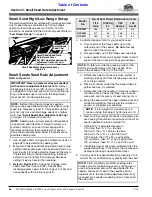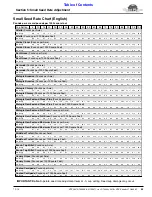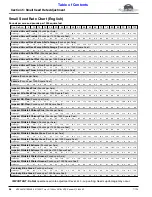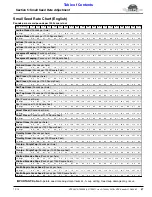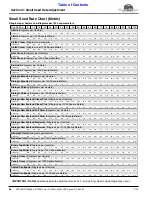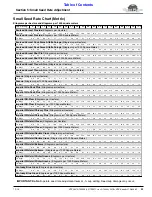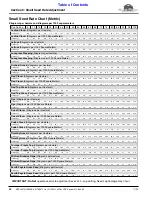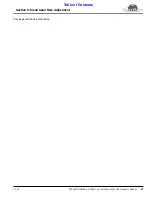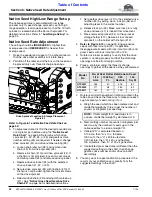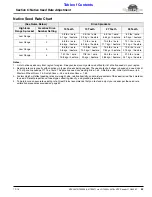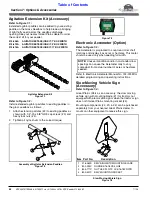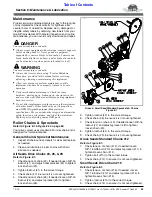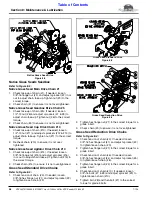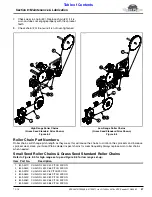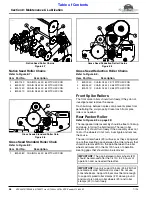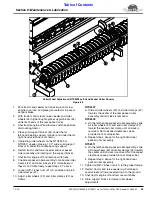
Section 5: Small Seed Rate Adjustment
NTS2507, NTS2509, & NTS2511 s/n+ 2019+ NTS Seeder 313-900M
7/1/19
44
Small Seed High/Low Range Set-up
The small seed drive is associated with low range sprocket
only. If speed change sprocket is set for high range
operation, rearrange sprocket so that the 19 tooth
sprocket is located behind the 35 tooth sprocket. Refer to
Small Seed Rate Adjustment Lever
Figure 5-1
Small Seeds Seed Rate Adjustment
Refer to Figure 5-1:
1.
Use English charts on page 45 and Metric charts on
page 48 to help determine seeding rate.
2.
Move small seeds seed rate adjustment lever to cup
setting number obtained in the seed rate charts. For
best results, first move adjustment lever all the way to
the left and then to the desired setting. Increase
setting if seed is lighter than average. Decrease
setting if seed is heavier than average.
3.
Refer to Figure 2-13
on page 30: Engage small
seeds with lock in/out pin (#5). If applicable,
disengage grass seeds lock in/out pin (#3 or #4) and
native seeds with lock in/out pin (#2).
Small Seeds
Seed Cup
39027
Small Seeds Seed Rate
Adjustment Lever
DO NOT operate seeder with
adjustment lever set on 0.
IMPORTANT:
Never operate small seeds seedbox
with seed rate adjustment lever set at 0.
Always
disengage lock in/out pin (#5) shown in Figure 2-13
on page 30 to stop seed cups from turning. Allowing
any of the seed cups to turn with the adjustment
lever set at 0 will damage the cups.
NOTE:
Before filling the small seeds seedbox,
make sure all seed cups will fully close when moving
seed rate adjustment lever to 0. Any seed cup that
will not fully close will discharge seeds at a higher
rate. See
“Small Seeds Zero Adjustment Set-up”
on page 13 for detailed instructions.
NOTE:
Seeding rates will vary greatly with variations
in seed size, seed treatment, weight of seed, soil
surface condition, and rear roller slippage. We
recommend that you test and adjust your seeder
using the procedures listed below to help ensure an
accurate seeding rate.
4.
Calibrate dispersal rate for your specific seed:
a. Poor seed over the three seed cups at the
outboard end of the seeder.
Do not
allow any
seed to reach the other cups.
b. Pull seed tubes out of the three seed cup drops.
c. Lower seeder frame onto support blocks that will
support the rear roller just above ground level.
d. Rotate rear roller to make sure drive system is
working properly and that the feed cups are free
from foreign matter.
e. Place a container under the three seed tubes to
gather seed as it is metered.
f. Rotate rear roller the number of rotations noted in
the table above. Check the three cups to make
sure each cup has plenty of seed coming into it.
g. Weigh the seed which has been metered out and
divide that weight by three to get the number of
pounds or kilograms per seed cup.
h. Next, multiply number of pounds or kilograms per
seed cup by the number of seed cups on the small
seeds seedbox to arrive at weight “A”.
i. If Weight “A” is calculated based on:
1/10 acre, then “A” x 10 = lbs/acre
1000 sq ft, then “A” x 43.56 = lbs/acre
1000 sq ft, then “A” x 1 = lbs/1000 sq ft
1/20 hectare, then “A” x 20 = kgs/hectare
100 sq meters, then “A” x 100 = kgs/hectare
100 sq meters, then “A” x 10 = kgs/1000 sq m
j. If calculated grass seed rate is different than the
suggested settings in the charts, then increase or
decrease the seed cup adjustment lever.
5.
You may want to repeat calibration procedure if the
results of your calibration vary greatly with the chart.
Model
No
No. of Rear Roller Rotations to Cover
1/10
Acre
1000 Sq.
Ft.
1/20
Hectare
100
Sq. M
NTS2507
266
61
329
66
NTS2509
207 48
256
52
NTS2511
169 39
209
42
NOTE:
Rotate rear roller by grasping roller at the
bottom and pulling away from the seeder. Push
toward the seeder at the top of the roller.
NOTE:
If total weight for 3 seed cups is in
ounces, divide that weight by 48 instead of 3.
NOTE:
Field conditions will affect seeding rates.
Check amount of seed being used by noting size of
area being seeded, amount of seed added to the
seeder, and level of seed in the seedbox. Minor
adjustments to the seed rate adjustment lever may
be necessary if seeder is seeding more or less seed
than desired.
Section 5: Small Seed Rate Adjustment

